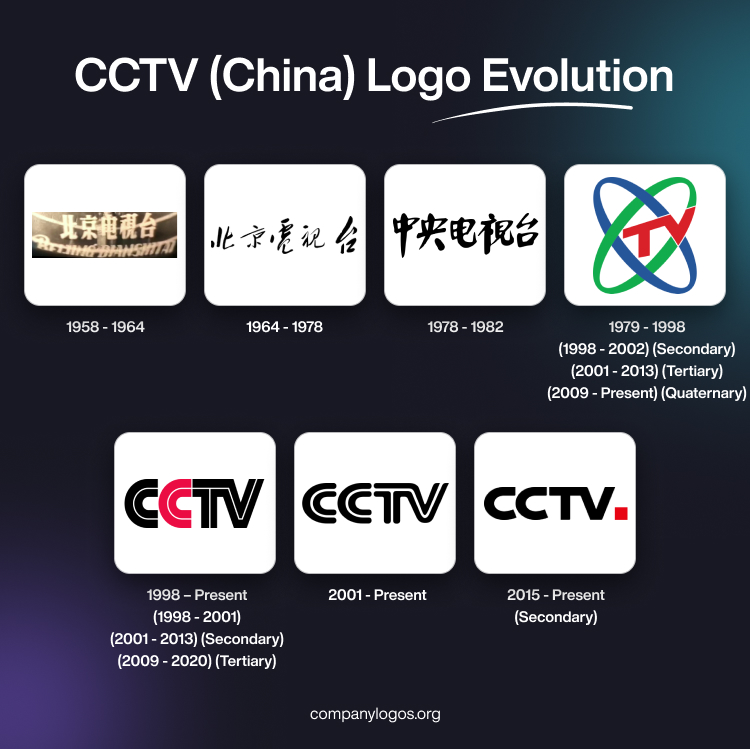
CCTV is arguably the largest state-owned broadcaster in China with a huge viewership. It began as Beijing Television in 1958, before being renamed China Central Television on May 1, 1978. The China Central Television (CCTV) logo has undergone several changes since the inception of the network. These logo iterations show both technological advancements and shifts in China’s media landscape. The article delves into the evolution of the CCTV (China) logo and provides details about other aspects of the company.
The Genesis of the CCTV (China) Logo (1958 – 1964)
The original logo of CCTV (China) showed the Chinese inscription of Beijing Television, which was founded on 1st May 1958. The Chinese inscription used a custom Song typeface, aka Hanyu Pinyin. The wordmark also mentioned “Beijing Dianshitai” in calligraphy.

(1964 – 1978)
Designed by Mao Zedong, the 1964 logo of Beijing Television was written using Chinese calligraphy.

(1978 – 1982)
On 1st May, 1978, Beijing Television was renamed China Central Television. This momentous occasion was represented by a logo change and designed by Hua Guofeng. It showed the new name in a bold and custom Chinese inscription.

(1979 – 1998)
(1998 – 2002) (Secondary), (2001 – 2013) (Tertiary), and (2009 – Present) (Quaternary)
On New Year’s Day 1979, CCTV introduced what would become its most recognisable logo. It was designed by then-employee Zhang Desheng. This design, often nicknamed the “butterfly” or “atom”, featured a stylised, symmetrical motif that suggested both modernity and connectivity. The logo’s abstract form symbolised the network’s ambition to serve as a central node in China’s rapidly developing broadcast infrastructure.
Designed in a red, green, and blue colour palette, the logo consisted of two overlapping circles placed at an angle to each other. The wordmark “TV” in red appeared at the centre in such a way that the letter “V” followed the path of the two circles.

(1998 – Present)
(1998 – 2001), (2001 – 2013) (Secondary), and (2009 – 2020) (Tertiary)
The 1998 logo iteration was designed by Akira Hasegawa, Tadashi Nakatani, and Tomoki Suzuki of Sun & Moon Inc. Nicknamed “Double-line” by fans, the logo featured the abbreviation “CCTV” in a red, white, and black colour combination and written using custom typography.

(2001 – Present)
In 2001, the “Double-line” logo was tweaked to make it look more attractive using a custom typeface. The typeface was characterised by small-sized and roundish letters.

(2015 – Present) (Secondary)
The 2015 logo was designed by Zhengbang Design, and it featured the abbreviation “CCTV” in black using a custom typeface. There was a small red square at the end of the abbreviation.

The Elements of the CCTV (China) Logo
Font
The wordmark used in the CCTV (China) logo employs a custom, bold, sans-serif typeface. The letters in the wordmark are clean and modern, with a strong geometric quality that conveys authority and professionalism. Also, since the design is unique to CCTV and is not a standard commercial font, it ensures instant recognisability and a sense of exclusivity.
Colour
The CCTV (China) logo features a black and red colour scheme. Here, black is used to depict most of the letters, and the colour symbolises strength, authority, and seriousness. Besides, it aligns with the status of CCTV (China) as China’s national television network.
The red colour, on the other hand, is used in the inner curve of the first letter “C”. Moreover, the colour is deeply associated with China and represents luck, vitality, and national pride. This red accent also adds a dynamic, eye-catching element to the otherwise monochrome design.
The History of CCTV (China)
China Central Television (CCTV) traces its origins to the mid-1950s, when Mao Zedong first proposed the idea of a Chinese television station in 1954. By 1955, the central broadcasting bureau had developed a plan for a medium-sized television station. This was subsequently included in China’s first five-year plan under the direction of Premier Zhou Enlai.
In 1957, Chinese experts travelled to the Soviet Union and East Germany to study their television systems. They returned to Beijing to lay the groundwork for China’s own broadcaster. CCTV began as Beijing Television and aired its first experimental broadcast on May 1, 1958. At that time, television sets were extremely rare. In fact, there were only about 50 in existence, mostly for government officials. Besides, programming was limited to a few hours in the evenings, which covered only the Beijing area.
On May 1, 1978, Beijing Television was officially renamed China Central Television (CCTV) to mark its 20th anniversary with a new logo and a broader national mission. Throughout the late 1970s and 1980s, CCTV expanded its reach and technological capabilities. It began broadcasting colour programming in 1973 and transitioned to full-time colour programming by 1977. In 1980, CCTV experimented with news relays via microwave technology and embarked on its first international collaboration. It produced the Silk Road documentary with Japan’s NHK.
The establishment of the China International Television Corporation (CITVC) in 1984 helped manage overseas business. By the mid-1980s, CCTV had become China’s leading television network, which exported thousands of programmes globally and produced landmark dramas such as Dream of the Red Chamber (1987). It became the first Chinese TV drama to reach international audiences.
The 1990s brought significant reforms as CCTV opened prime-time advertising slots in 1994 and expanded its channel offerings. The broadcaster diversified into specialised channels, which included news, sports, documentaries, and international content, and also began satellite and digital broadcasting. By 1997, CCTV operated hundreds of government-owned stations and relayed content through an extensive national and international network.
In the 2000s and beyond, CCTV continued to modernise. It launched high-definition broadcasts and expanded into new media platforms such as internet TV, mobile TV, and IPTV. It now operates dozens of channels, including six international channels broadcasting in Chinese, English, French, Spanish, Russian, and Arabic. The channel reaches over a billion viewers worldwide.
CCTV has played a major role in broadcasting national events, such as the live coverage of the 60th anniversary of the People’s Republic of China in 2009, which was transmitted across multiple platforms and in six UN languages. In March 2018, CCTV became part of the newly formed China Media Group. This consolidated state media operations under one umbrella as part of broader institutional reforms.
Throughout its history, CCTV has served as a key mouthpiece for the Chinese Communist Party, wherein it shaped public opinion and disseminated government policy. It remains a primary source of news, education, culture, and entertainment for the Chinese public. It is also an important channel for the world to understand China. With a global network of news bureaus and partnerships, the evolution of CCTV from a small, local broadcaster to a global media powerhouse shows China’s own transformation on the world stage.
Interesting Facts About CCTV (China)
- Founded in 1958, CCTV is the main television broadcaster for China and is headquartered in Beijing. Its first official broadcast was on September 2, 1958.
- CCTV is state media and is owned by the Publicity Department of the Chinese Communist Party. It is a key tool for the government to share news, education, and entertainment, as well as to communicate official messages and policies.
- The network was originally called Beijing Television before being renamed to CCTV on May 1, 1978.
- CCTV operates a vast network of channels. It has up to 50 channels, which include 25 free and 19 pay channels. These make it the TV station with the largest number of channels in the world.
- Its broadcast area is worldwide, and it runs six international channels in six languages: Chinese, English, French, Spanish, Russian, and Arabic, reaching more than a billion viewers.
- CCTV’s flagship news programme, Xinwen Lianbo, airs daily at 7:00 pm. It has an estimated regular audience of nearly 500 million people.
- The New Year’s Gala of CCTV is the most-watched TV show in China and one of the most-watched entertainment programmes in the world. It attracts more than 90% of the national audience during its broadcast.
- CCTV has played a key role in broadcasting historic events, such as the live coverage of the 60th anniversary of the People’s Republic of China in 2009. This particular event was transmitted in six United Nations languages and in high definition across multiple platforms, including TV, the internet, and mobile devices.
- The broadcaster is a technological leader, with advanced studios, digital production systems, and a global network of news bureaus and partnerships.
- CCTV is part of the China Media Group, which consolidates several major state media organisations under one umbrella.
- The network’s headquarters in Beijing is architecturally iconic. It features a distinctive angular-looped structure designed by Rem Koolhaas and symbolises CCTV’s modern and global outlook.
Finally
The evolution of the CCTV (China) logo encapsulates the journey of the broadcaster from a domestic, state-run channel to a sophisticated, global oriented media conglomerate. Each logo redesign reflects broader changes in Chinese society, technology, and the global role China seeks to play through its media.